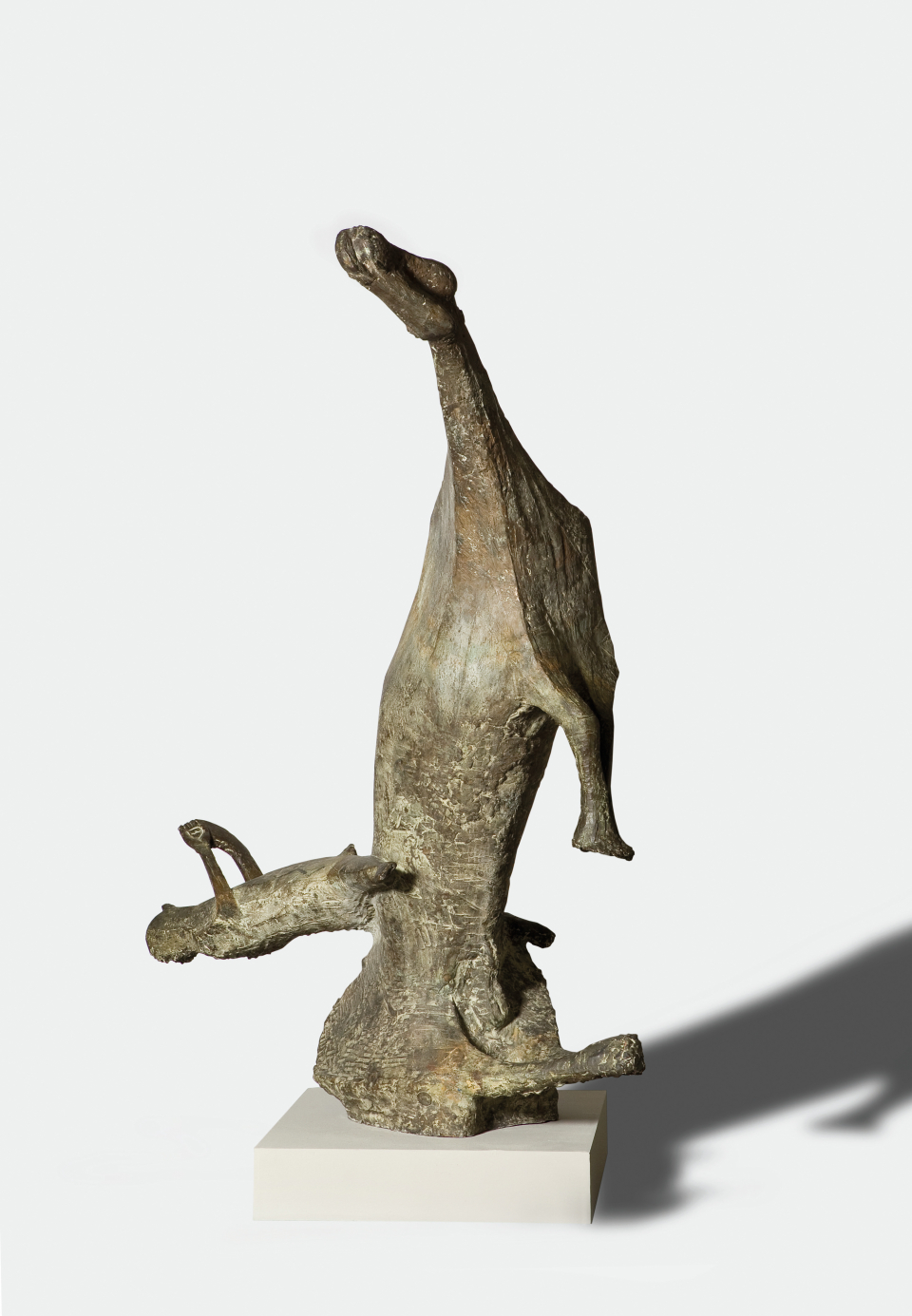Hector-Bau > Ebene 1 > Kubus 3
Intro
There is hardly a theme that appears more frequently in the work of Marino Marini than that of horse and rider. With this motif the Italian sculptor both explored the history of equestrian sculpture and, from the 1950s on, addressed existential questions.
The wild, animalistic power of the horse finds its expression in its taming by man – its rider. After World War II, however, this symbol of domination and control underwent a significant change in Marini’s work. Now both horse and rider fall, conveying a tragic impression. They look threatened, at the mercy of circumstances.
In »Miracle«, this fall is very clear, with Marini exploring the extreme tension between the vertically extended body of the horse and the horizontal human body falling backward. The surface of the bronze is agitated, the forms radically simplified. The title of this work also brings a religious interpretation into play, for it is through his fall from a rearing horse that Saul the persecutor of Christians became Paul the Apostle.
Background
“It was towards the end of the War: bombs were falling, sleepless nights; I saw through the train window how a horse took fright and the rider, who almost seemed to fly through the air, fell in the next moment to the ground. […] The creature lay on the ground, but the heavenward gesture remained and became for me an equation for form and life.” This memorable experience led the Italian sculptor Marino Marini to a decade-long study of the traditional monument in the form of the equestrian statue, which he brought forward into modern sculptural history in a unique manner.
The bronze sculpture »Miracle« is part of a series of equestrian monuments, in which, from the 1950s onward, the artist recorded the inexorable fall of man and beast, and interpreted the scene as the expression of a miraculous, existential event. In turn, Marini depicted the impact of the rider and the horse in a series of works entitled »The Scream«. He himself described the development of both groups as increasingly dramatic, since the rider progressively lost control over his horse. “All this, because I believe that we are approaching the end of a world.” The rider and horse, paralysed in their fall, were ciphers representing the social situation after the Second World War. Throughout Europe, the horrors of war had left not only fear and despair, but also a heightened awareness for the threats to man and his dignity. Marini’s equestrian monuments have nothing in common with classical equestrian statues, which usually depicted a monarch or a general sitting proudly on his striding or rearing horse. In these sculptures – the visual representation of the sovereignty and authority of the ruler – the horse, symbolising the people, was always completely under control. In Marini’s sculptures, on the other hand, this power is finally broken – a model of society and its ideologies had come to an end.
Formally, Marini’s »Miracle« sculptures are characterised by an increasing simplification of forms and extreme tension, which results from the contrast between vertical, horizontal and diagonal volumes. Form and movement are condensed in large, planar and occasionally rough shapes. In fact, in abstract reduction, Marini saw the way back to figurative representation and the natural model, since the essence could be expressed in this form. Characteristic is also the restless, almost painterly treatment of the sculpture’s surface. This trend continued to increase as Marini’s work developed. At the beginning of his artistic career, he created balanced, archaic equestrian statues, which took as their reference Etruscan sculptures from his native Tuscany. Marini developed his style in general from a relatively classical approach to sculpture, in which he also rejected radical movements such as Italian Futurism. The study of classical and antique models of Italian sculptural art also explains Marini’s enthusiasm for the subject of the rider, which he consciously preferred to subjects regarded as modern – for example, the relationship between man and machine, the equation of speed and progress and the avant-garde break with all traditions. And yet the effect of his falling rider continues to win over viewers to this day as the expression of a completely new, modern understanding of sculpture.
Kunsthalle Mannheim
Transkription
We see a horse’s body stretched upwards, with the body of its rider falling towards the back. The surface of the bronze is agitated, the forms have been radically simplified. The work seems to have frozen in mid-movement, doesn’t it? As if it were pausing for a second, before the rider falls to the ground, before his horse runs away.
There is hardly a subject that appears more frequently in the work of Marino Marini than that of horse and rider. What comes to your mind when looking at an equestrian statue? Surely, you think first of the depiction of a glorious hero. But this Italian sculptor uses that particular constellation to address existential questions.
First of all, he examines the issues of domination and impulsive force. The wild, brute power of the horse finds expression in its taming by man – its rider. After World War II, however, this symbol of domination and control underwent a significant change in Marini’s work.
He believes now that the world is approaching its end, and expresses this view in his sculpture; as he expresses it in his own words: „I want (…) to erect a memorial to the Tragic, a kind of twilight of mankind which is a defeat, not a victory.«
Now, both horse and rider fall, conveying a tragic impression. Both look threatened, at the mercy of mere circumstances.
